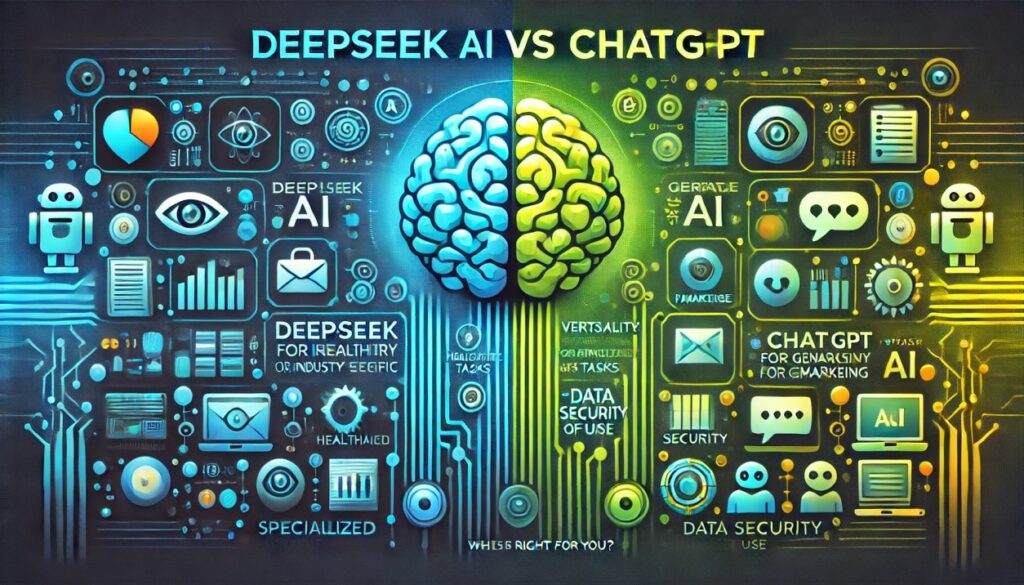In the rapidly evolving world of artificial intelligence, two names have been making waves: DeepSeek AI and ChatGPT. Both are powerful AI tools designed to assist users in various tasks, from content creation to customer support. But which one is better? In this article, we’ll dive deep into the DeepSeek AI vs ChatGPT debate, exploring their features, strengths, weaknesses, and use cases. We’ll also answer some common questions like Is DeepSeek R1 better than ChatGPT? and How to use DeepSeek? to help you make an informed decision.

Table of Contents
1. Introduction to DeepSeek AI vs ChatGPT
What is DeepSeek AI?
DeepSeek AI is an advanced artificial intelligence platform designed to assist users in generating high-quality content, automating tasks, and providing data-driven insights. It is particularly known for its DeepSeek R1 model, which is optimized for natural language processing (NLP) and machine learning tasks. DeepSeek AI is widely used in industries like marketing, healthcare, and finance for its accuracy and efficiency.
What is ChatGPT?
ChatGPT, developed by OpenAI, is a state-of-the-art language model that excels in generating human-like text. It is based on the GPT (Generative Pre-trained Transformer) architecture and is widely used for tasks like content creation, chatbots, and customer support. ChatGPT is known for its versatility and ability to handle a wide range of queries.
2. DeepSeek AI vs ChatGPT: Key Features
DeepSeek AI Features
- DeepSeek R1 Model: Optimized for NLP tasks, offering high accuracy and speed.
- Customizable Solutions: Tailored AI solutions for specific industries.
- Data Security: Advanced encryption and compliance with data protection regulations.
- Multi-Language Support: Capable of understanding and generating content in multiple languages.
- Integration: Easy integration with existing software and platforms.
ChatGPT Features
- GPT-4 Architecture: The latest version offers improved context understanding and response quality.
- Versatility: Suitable for a wide range of applications, from casual conversations to professional content creation.
- User-Friendly Interface: Easy to use, even for non-technical users.
- Large Knowledge Base: Trained on a vast dataset, enabling it to answer a wide variety of questions.
- API Availability: Developers can integrate ChatGPT into their applications via APIs.
3. Is DeepSeek R1 Better Than ChatGPT?
The question Is DeepSeek R1 better than ChatGPT? depends on your specific needs. Here’s a breakdown:
When DeepSeek R1 Shines
- Industry-Specific Tasks: DeepSeek R1 is designed for specialized tasks, making it ideal for industries like healthcare, finance, and legal.
- Data Security: If data privacy is a top priority, DeepSeek’s advanced security features give it an edge.
- Customization: DeepSeek offers more tailored solutions compared to ChatGPT’s general-purpose approach.
When ChatGPT Excels
- Versatility: ChatGPT is better suited for general-purpose tasks like content creation, casual conversations, and customer support.
- Ease of Use: ChatGPT’s user-friendly interface makes it accessible to a broader audience.
- Community Support: Being a widely used tool, ChatGPT has a large community and extensive documentation.
4. How to Use DeepSeek AI
If you’re wondering How to use DeepSeek?, here’s a step-by-step guide:
Step 1: Sign Up and Log In
- Visit the DeepSeek AI website and create an account.
- Log in to access the dashboard.
Step 2: Choose Your Model
- Select the DeepSeek R1 model or any other model that suits your needs.
Step 3: Input Your Data
- Upload your dataset or input your query directly into the platform.
Step 4: Customize Settings
- Adjust parameters like language, tone, and output format to match your requirements.
Step 5: Generate Output
- Click on the “Generate” button to get your results.
- Review and refine the output as needed.
Step 6: Integrate and Deploy
- Use the generated content or insights in your workflow.
- Integrate DeepSeek AI with your existing tools via APIs.
5. Use Cases: DeepSeek AI vs ChatGPT
DeepSeek AI Use Cases
- Healthcare: Analyzing patient data and generating reports.
- Finance: Predicting market trends and automating financial reports.
- Legal: Drafting legal documents and contracts.
- Marketing: Creating personalized marketing campaigns.
ChatGPT Use Cases
- Content Creation: Writing blogs, articles, and social media posts.
- Customer Support: Powering chatbots for instant customer assistance.
- Education: Providing tutoring and answering student queries.
- Entertainment: Generating creative writing, jokes, and stories.
6. Pros and Cons of DeepSeek AI vs ChatGPT
DeepSeek AI Pros
- High accuracy in specialized tasks.
- Strong data security features.
- Customizable for specific industries.
DeepSeek AI Cons
- Limited versatility compared to ChatGPT.
- Steeper learning curve for beginners.
ChatGPT Pros
- Highly versatile and user-friendly.
- Large community and extensive documentation.
- Suitable for a wide range of applications.
ChatGPT Cons
- May lack depth in specialized tasks.
- Data privacy concerns for sensitive applications.
7. Conclusion: Which One Should You Choose?
The DeepSeek AI vs ChatGPT debate ultimately boils down to your specific needs. If you’re looking for a specialized tool with strong data security and customization options, DeepSeek AI is the way to go. On the other hand, if you need a versatile, user-friendly AI for general-purpose tasks, ChatGPT is the better choice.
Both tools have their strengths and weaknesses, and the best option depends on your use case. Whether you’re asking Is DeepSeek R1 better than ChatGPT? or How to use DeepSeek?, the key is to evaluate your requirements and choose the tool that aligns with your goals.
